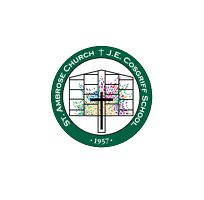J.E. Cosgriff Memorial Catholic School student earns Young Scientist of the Year award
SALT LAKE CITY — Lauren Hilde-brand, 12, a seventh-grade student at J.E. Cosgriff Memorial Catholic School, earned the Young Scientist of the Year award at the 2025 Diocesan Science and Engineering Fair, held Feb. 1 at Juan Diego Catholic High School. She also received the Overall Plant Science Award, the Overall Seventh Grade Award, and first place in the seventh-grade plant science category.
For her project Lauren examined which of four selected plants consumed carbon dioxide the fastest. Her project was inspired by her concern about the planet’s warming and the potential for catastrophic change if humankind does not seriously address the issue quickly, she said.
This was her first time participating in a science fair and the experience was very positive, she said, although she ran into problems early with the dry ice she was using to produce carbon dioxide for her experiment.
“Something happened as we were trying to test, and it wasn’t working,” she said. “And so it really worried me, and I started panicking that there was a hole in my greenhouse, or something was wrong with my sensor, but my parents helped me to just stay calm and try to think of what to do.”
Through trial and error, she learned the source of the problem was that the dry ice was not giving off a sufficient amount of carbon dioxide. Switching to a combination of baking soda and vinegar got her project back on track and led her to discover that plants with the largest surface area on their leaves absorbed the most carbon dioxide.
Dealing with that bump in the road, “I learned how to adjust your mind and not get into, like, such a tunnel of what you’re trying to do, and to learn that it’s OK to change in the middle of what you’re doing in order to be successful,” Lauren said.
Beyond the satisfaction of seeing her project do so well in the competition, Lauren also learned from participating in the fair valuable life skills such as how to stay calm in tough situations, she said. “Even with the science fair, with all the due dates, and things like making sure my report was perfect and making sure everything was good for the due date, realizing to stay calm in stressful situations, that will help things be more successful. And I can use that for things that aren’t just academics; I can use that for everything in my life.”
One of the reasons Lauren’s project was so well-received was because of the timeliness of her subject, said Patrick Humlicek, a science teacher at J.E. Cosgriff Memorial School.
Citing recent record-breaking temperatures, Lauren said her project is also a warning for future generations. “It means that the carbon dioxide levels in our atmosphere are so high that our temperature in our weather isn’t normal, which is a problem because then in future generations, if we keep doing what we’re doing to the atmosphere now, eventually it’s going to be so unhealthy that it’s impossible to live in the conditions.”
The win at the diocesan science fair qualified Lauren for the University of Utah Science and Engineering Fair on March 13, where she will compete with peers from across the state. She is looking forward to the experience, she said.
She will continue to attend J.E. Cosgriff for eighth grade and plans to attend Judge Memorial Catholic High School, where her older brothers Vincent and Isaac are students. After attending college, she would like to work as a NASA scientist.
Isaac Hildebrand served as a NASA intern last summer and, along with fellow Judge student Rowan Hankins, presented their project from that time to eminent physical scientists at the American Geophysical Union conference, held in Washington, D.C. in December. (See story in the Feb. 7 Intermountain Catholic.)
For this year’s diocesan science fair, the 13 J.E. Cosgriff students who participated largely came up with the ideas for their projects on their own, said Humlicek, who taught his students the scientific method and shared resources with them.
“At that point it was mostly on them, honestly,” he said. “I treated this more of a student-run project, where I was just there for guidance, and it was the student who was supposed to be coming up with the experiment and finding their own solution to their problem.”
Humlicek said he thinks the science fair “is a phenomenal experience for every single student. It gives them a lot of opportunity to present a complex topic that they spent a lot of time researching and becoming an expert on, and I find that it’s very important for them to gain that knowledge and then help explain to someone who might not be as knowledgeable in the area.”
© Copyright 2025 The Diocese of Salt Lake City. All rights reserved.


Stay Connected With Us